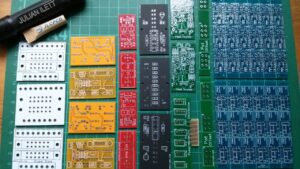First of all, PCBs, as printed circuit boards, primarily provide the interconnection between electronic components. Color is not directly related to performance, and differences in pigmentation do not affect electrical properties. the performance of a PCB is determined by the materials used (high Q), wiring design, and several layers of the board. However, in the process of washing PCBs, black is the most likely to cause color differences, if the PCB factory to use the raw materials and production process is slightly deviated, it will cause the PCB defect rate because of color differences. This directly leads to an increase in production costs.

In fact, the raw material for PCBs is something we see everywhere in our daily lives: glass fibers and resins. Glass fibers and resin combine and harden into a board that is insulated, insulated, and does not bend easily, which is the PCB substrate. Of course, the PCB substrate made from the combination of glass fiber and resin alone cannot conduct signals, so on the PCB substrate, the manufacturer will cover the surface with a layer of copper, so the PCB substrate can also be called a copper-clad substrate.
Because the circuit alignment of a black PCB is hard to read, it makes it more difficult to maintain and debug during the R&D and after-sales stages, and generally brands without a strong RD (research and development) design staff and a strong repair team will not readily use a black PCB. It can be said that using a black PCB is a sign of confidence for a brand’s PCB design and post maintenance team, and from the side, it is also a reflection of the manufacturer’s confidence in their own strength.
For these reasons PCB manufacturers are careful when selecting PCB layout designs for their products. As a result, most of the products that shipped in the market that year used red PCBs, green PCBs, or blue PCB versions, and only saw black PCBs on mid-range or top flagship products, so stop thinking that black boards are better than green PCBs.














